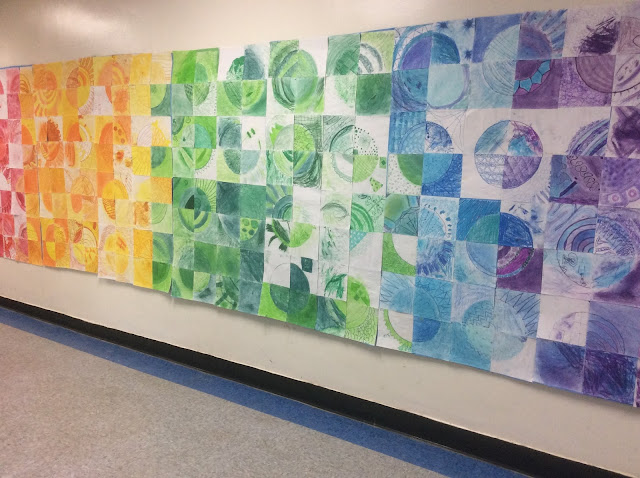The other day a really happy child said the kindest, most genuine thing after her art class:
"Mrs. Elliott, I love the teacher you are being!"
I know what she meant, actually. That class had gone really well. The students loved the lesson, because during it, I make big mistakes, get fussy, ask for their help to calm myself, and have them help me fix my problems. Then I give them tons of positive, all-class, everyone-one-look-over-here-at-this-cool-idea attention when they can solve their own challenges calmly.
In other words, I make a point, a whole lesson, out of being human. Kids love it. Sometimes you get to be the teacher that you want to be, and the teacher your students want. I aspire everyday in education to be a little more human for my students.
The pictures in this post show student work with their stated problems and solutions.
 |
| "I didn't mean to make two pink circles next to each other, so I colored them in differently." |
To do this in a way that is meaningful and fair, I model making a mistake. Sometimes I invite a student to "ruin" my artwork to make this point, but more recently I am surprising my students by making an error and acting very upset by it, making sure that my reaction is totally out of proportion to the size of the problem, so that they are convinced I must be passionately angry/disappointed by my error.
 |
| "My black looked really scribbly, so I just did the same thing to a bunch more so it look on purpose." |
Take deep breaths, Mrs. Elliott!
Count backwards in your head from ten.
Take a short walk around the room then come back.
 |
| "I don't really like how the pink looks in this circle [top left], but I just took a big breath and decided it wasn't a big deal." |
These kids have amazing skills. And they are also human, so they have big feeling sometimes. They know exactly how to help themselves feel calm, but it is hard to do, you know, in the moment. So, I task them with this: If you make a mistake today, and figure out how to solve it, raise your hand, tell me about it, and I will stop the class to celebrate your solution.
 |
| "My blue went out the lines in my circle [top center], so I just colored the rest of my paper blue and it looks really good." |
Frankly, I am more proud of good solutions to perceived errors than I am of an artwork that went flawlessly and without bumps. If there is one thing that I hope students will get out of art, it's creative thought about solutions to their problems in life.






















